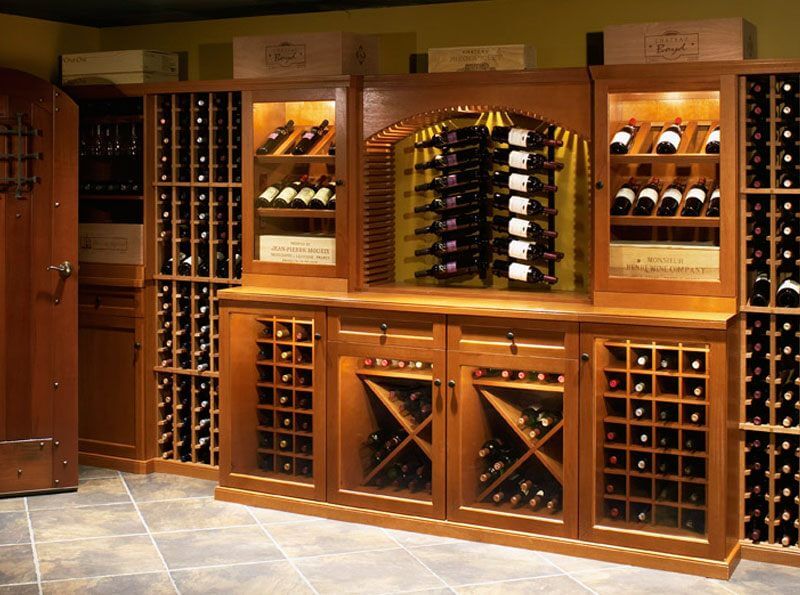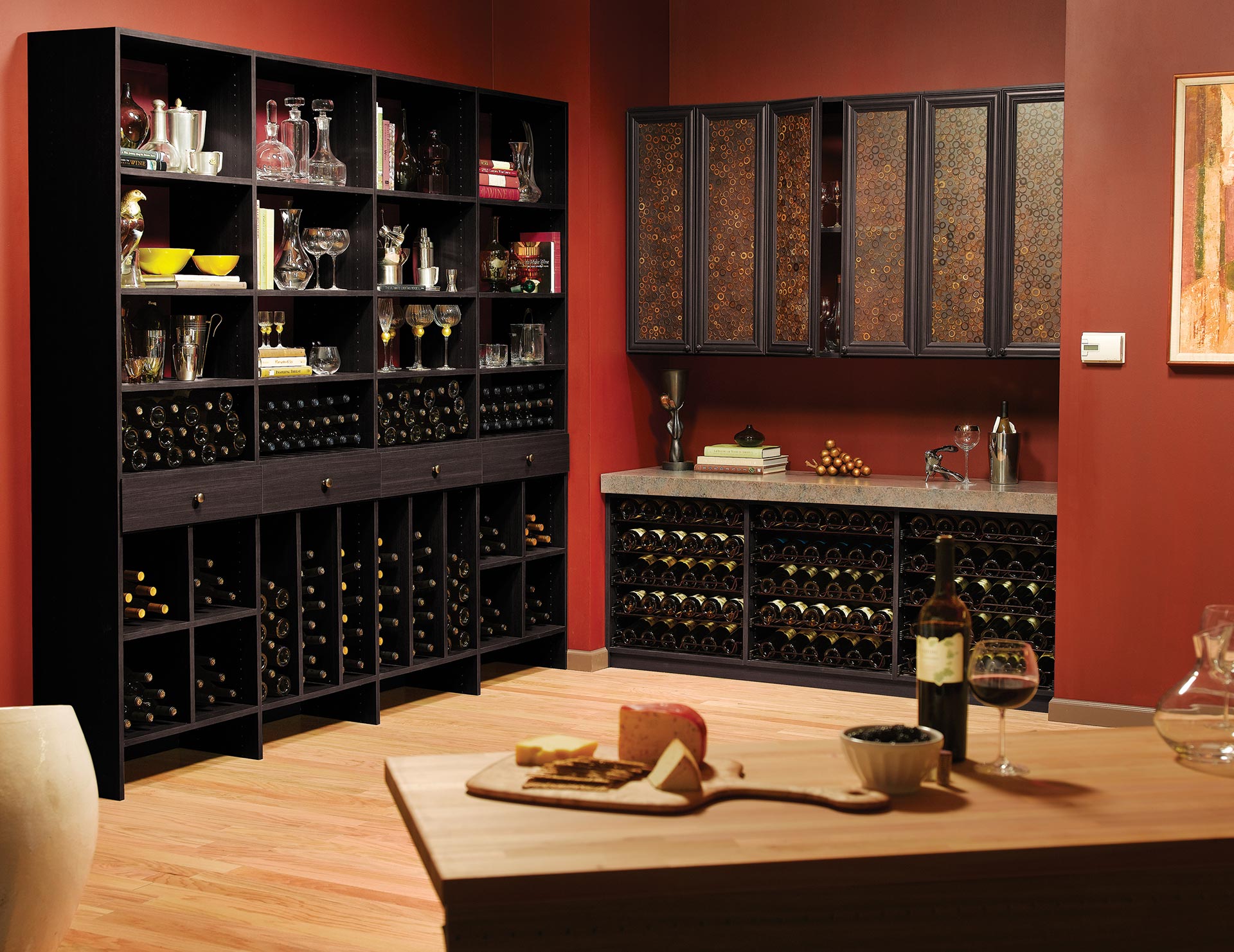Wine Cabinet Design & Functionality

A wine cabinet is a specialized storage unit designed to preserve and enhance the quality of your wine collection. They provide a controlled environment that mimics the ideal conditions found in a traditional wine cellar.
Types of Wine Cabinets
Wine cabinets come in various styles and designs, each with unique features and benefits.
- Thermoelectric Wine Cabinets: These cabinets use a semiconductor chip to cool and regulate the temperature, making them energy-efficient and quiet. They are ideal for smaller collections and are often compact in size.
- Compressor Wine Cabinets: These cabinets use a compressor to cool and regulate the temperature, offering greater cooling power and larger capacity. They are suitable for larger collections and can maintain a more consistent temperature.
- Single-Zone Wine Cabinets: These cabinets have a single temperature zone, ideal for storing wines at a consistent temperature. They are suitable for storing wines meant for immediate consumption or those that require a similar temperature range.
- Dual-Zone Wine Cabinets: These cabinets have two separate temperature zones, allowing you to store both red and white wines at their optimal temperatures. They offer flexibility and versatility for storing a diverse wine collection.
- Multi-Zone Wine Cabinets: These cabinets have multiple temperature zones, providing the ultimate flexibility for storing wines at various temperatures. They are ideal for large collections and allow you to store wines for different occasions and preferences.
Choosing the Right Size and Capacity, Living spaces wine cabinet
Determining the appropriate size and capacity for your wine cabinet is crucial.
- Collection Size: Consider the number of bottles you currently have and your anticipated growth in the future.
- Space Availability: Measure the available space in your living room or dining area to determine the maximum size and capacity of the cabinet you can accommodate.
- Usage Frequency: If you frequently consume wine, a larger capacity might be beneficial. If you prefer a smaller collection, a compact cabinet may suffice.
Integrating Wine Cabinets into Living Spaces
Wine cabinets can be seamlessly integrated into various living space designs.
- Modern Living Spaces: Sleek, minimalist cabinets with glass doors and metal accents complement modern décor.
- Traditional Living Spaces: Cabinets with wood finishes, ornate details, and a classic design enhance the ambiance of traditional living spaces.
- Minimalist Living Spaces: Compact, freestanding cabinets with simple lines and neutral colors blend seamlessly into minimalist interiors.
Essential Features of a Wine Cabinet
Wine cabinets are equipped with essential features that ensure optimal wine storage conditions.
- Temperature Control: Maintaining a consistent temperature is crucial for preserving the quality and flavor of wine. Most wine cabinets offer a temperature range between 45°F and 65°F (7°C and 18°C), allowing you to store different types of wine at their optimal temperatures.
- Humidity Regulation: Humidity levels play a vital role in preventing cork dryness and oxidation. Ideal humidity levels for wine storage are between 50% and 70%. Wine cabinets often feature built-in humidifiers to maintain optimal humidity levels.
- Lighting: Proper lighting is essential for showcasing your wine collection and enhancing the aesthetics of the cabinet. LED lighting is often preferred for its energy efficiency and low heat output.
Wine Cabinet Placement & Integration: Living Spaces Wine Cabinet

Choosing the perfect location for your wine cabinet is crucial for preserving your collection and enhancing its aesthetic appeal. Consider factors such as light exposure, temperature fluctuations, and accessibility to determine the ideal spot. Integrating the cabinet seamlessly into your living space requires careful planning and design.
Placement Considerations
The ideal placement for a wine cabinet balances functionality with aesthetics.
- Light Exposure: Direct sunlight can damage wine, so placing your cabinet in a shaded area or using UV-resistant glass is essential. Avoid placing it near windows that receive intense sunlight, especially during the hottest parts of the day.
- Temperature Control: Wine thrives in a cool, consistent environment. Ideally, the temperature should range between 55°F and 65°F (13°C and 18°C). Avoid placing your cabinet near heat sources like radiators or fireplaces.
- Accessibility: Choose a location that allows easy access to your wine collection. Consider the frequency with which you will be accessing the cabinet and the height of the placement for optimal comfort.
Integration in Different Living Spaces
Here are examples of how to seamlessly integrate a wine cabinet into various living space layouts.
- Open-Plan Spaces: A freestanding wine cabinet can be a focal point in an open-plan living area, separating the living room from the dining area. Consider using a cabinet with a glass front to showcase your collection.
- Dining Areas: Placing a wine cabinet near the dining table provides convenient access to wine during meals. A built-in cabinet can be incorporated into the dining room design, creating a cohesive and stylish look.
- Home Bars: A wine cabinet is a natural addition to a home bar. Choose a cabinet that complements the bar’s style and offers ample storage for both wine and barware.
Designing a Wine Cabinet Display Area
Creating a visually appealing and functional wine cabinet display area involves several factors.
- Lighting: Use warm, ambient lighting to highlight your wine collection. Recessed lighting, under-cabinet lighting, or decorative pendant lights can create a sophisticated ambiance.
- Arrangement: Arrange your wine bottles by type, vintage, or region. Consider using dividers or shelves to create visual interest and keep your collection organized.
- Accessories: Incorporate wine accessories such as decanters, glasses, and bottle stoppers into the display to enhance its aesthetic appeal and functionality.
Comparing Wine Cabinet Styles & Materials
The choice of style and materials for your wine cabinet depends on your personal preferences and the overall design of your living space.
- Wood: Wooden cabinets offer a classic and timeless appeal. They can be stained or painted to match your existing furniture. Oak, cherry, and mahogany are popular choices for their durability and elegance.
- Metal: Metal cabinets, such as those made from stainless steel or iron, offer a modern and industrial look. They are often durable and easy to clean.
- Glass: Glass cabinets provide a clear view of your wine collection, showcasing its beauty. They can be combined with wood or metal frames for a stylish and functional design.
Wine Cabinet Storage & Organization

Proper storage is crucial for preserving the quality and longevity of your wine collection. A well-organized wine cabinet not only enhances the aesthetics of your space but also ensures your wines age gracefully, ready for enjoyment when the time is right.
Wine Storage Conditions
Maintaining optimal storage conditions is paramount for preserving the quality of your wine. These conditions include temperature, humidity, and bottle positioning.
* Temperature: Ideal storage temperature for most wines is between 55°F and 65°F (13°C and 18°C). Fluctuations in temperature can negatively impact the aging process, potentially causing oxidation or premature aging.
* Humidity: Maintaining a humidity level between 60% and 70% is recommended. This prevents the corks from drying out, which could lead to air infiltration and oxidation.
* Bottle Positioning: Storing bottles on their side ensures the cork remains moist and prevents it from drying out. This also helps to distribute the wine evenly, keeping the cork in contact with the liquid.
Using Dividers, Shelves, and Racks for Wine Storage
Dividers, shelves, and racks are essential tools for maximizing storage space and creating a well-organized wine collection.
* Dividers: Dividers help to separate bottles of different sizes and types, preventing them from bumping and damaging each other. They also create distinct compartments for organized storage.
* Shelves: Shelves provide horizontal storage space, allowing you to stack bottles vertically. They can be adjusted to accommodate different bottle sizes and create distinct tiers for easy access.
* Racks: Racks offer vertical storage solutions, maximizing space by storing bottles on multiple levels. They are available in various styles and materials, catering to different aesthetic preferences and storage needs.
Visual Representation of Wine Storage Methods
* Horizontal Storage: Bottles are placed on their side, typically on shelves or racks, ensuring the cork remains moist and in contact with the wine.
* Vertical Storage: Bottles are stored upright, often in racks or on shelves, suitable for short-term storage or wines that are ready to be consumed.
* Stackable Storage: Bottles are stacked vertically, using dividers to separate and prevent damage. This method maximizes storage space in smaller cabinets.
* Wall-Mounted Racks: These racks offer a stylish and space-saving solution, attaching to the wall and displaying bottles prominently.
* Pull-Out Drawers: Drawers provide easy access to bottles, often equipped with dividers or racks for organization.
Wine Storage Accessories
| Accessory | Pros | Cons |
|---|---|---|
| Wine Bottle Holders | – Securely hold individual bottles – Offer a visually appealing display – Can be used in various settings |
– Limited storage capacity – May not be suitable for all bottle sizes |
| Wine Glass Racks | – Organize and store glasses efficiently – Enhance the aesthetic appeal of the cabinet – Can be customized to fit different glass sizes |
– May take up valuable storage space – Not essential for wine storage |
| Drawer Organizers | – Create compartments for efficient storage – Keep items organized and accessible – Can be customized to fit different drawer sizes |
– May not be suitable for all cabinet designs – Can be more expensive than other storage solutions |
Living spaces wine cabinet – Creating a dedicated space for your wine collection is a great way to enhance your living space. A stylish cabinet can showcase your bottles and add a touch of sophistication. If you’re looking for a sleek and modern option, consider the bjursta glass door cabinet brown black.
Its dark wood finish and glass doors create a timeless aesthetic that will complement any décor, making it a perfect addition to your living space wine cabinet.
A dedicated wine cabinet can be a beautiful focal point in your living space, but if you’re short on floor space, consider an under cabinet wine bottle rack as a stylish and practical solution. This clever design utilizes often-unused space, keeping your bottles organized and within easy reach while adding a touch of elegance to your kitchen or bar area.
